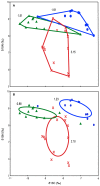Diet reconstruction and resource partitioning of a Caribbean marine mesopredator using stable isotope bayesian modelling
- PMID: 24236144
- PMCID: PMC3827373
- DOI: 10.1371/journal.pone.0079560
Diet reconstruction and resource partitioning of a Caribbean marine mesopredator using stable isotope bayesian modelling
Abstract
The trophic ecology of epibenthic mesopredators is not well understood in terms of prey partitioning with sympatric elasmobranchs or their effects on prey communities, yet the importance of omnivores in community trophic dynamics is being increasingly realised. This study used stable isotope analysis of (15)N and (13)C to model diet composition of wild southern stingrays Dasyatis americana and compare trophic niche space to nurse sharks Ginglymostoma cirratum and Caribbean reef sharks Carcharhinus perezi on Glovers Reef Atoll, Belize. Bayesian stable isotope mixing models were used to investigate prey choice as well as viable Diet-Tissue Discrimination Factors for use with stingrays. Stingray δ(15)N values showed the greatest variation and a positive relationship with size, with an isotopic niche width approximately twice that of sympatric species. Shark species exhibited comparatively restricted δ(15)N values and greater δ(13)C variation, with very little overlap of stingray niche space. Mixing models suggest bivalves and annelids are proportionally more important prey in the stingray diet than crustaceans and teleosts at Glovers Reef, in contrast to all but one published diet study using stomach contents from other locations. Incorporating gut contents information from the literature, we suggest diet-tissue discrimination factors values of Δ(15)N ≈ 2.7‰ and Δ(13)C ≈ 0.9‰ for stingrays in the absence of validation experiments. The wide trophic niche and lower trophic level exhibited by stingrays compared to sympatric sharks supports their putative role as important base stabilisers in benthic systems, with the potential to absorb trophic perturbations through numerous opportunistic prey interactions.
Conflict of interest statement
Figures





References
Publication types
MeSH terms
Substances
LinkOut - more resources
Full Text Sources
Other Literature Sources

